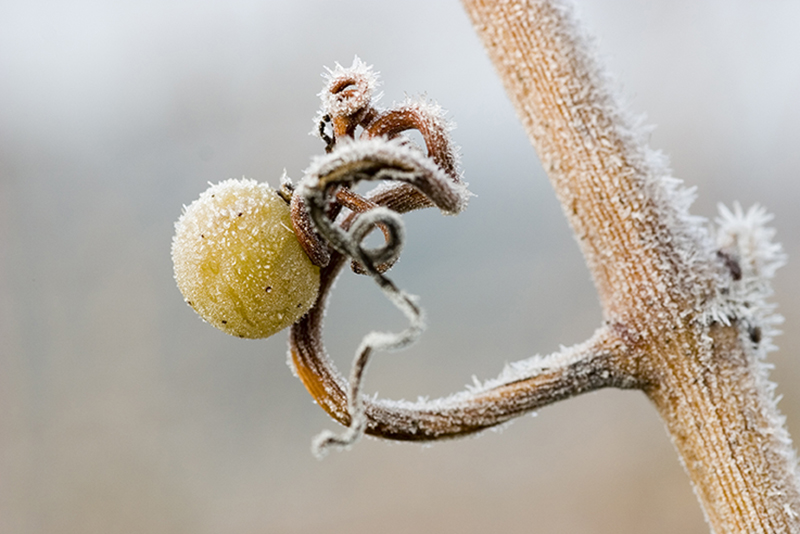Five steps to mitigate frost damage.
• www.hlhltd.co.uk • nick.rainsley@hlhltd.co.uk • 07909 686866
Spring frosts can be very damaging to vineyards, but it is possible to reduce the risks with careful planning, as Hutchinsons’ Chris Cooper and Rob Saunders explain.
Recent winters may have become milder and less severe, but late frosts still pose a significant risk to vineyards.
Yield can be lost through damage to primary bunch inflorescences, giving uneven grape maturity where a proportion of the crop arises from primary buds and the rest from secondary or tertiary buds. Tertiary and secondary bunches add cost as they generally need hard thinning later in the year to enhance ripening potential for a timely harvest.
Three years ago, some areas experienced early bud break following a mild winter and severe frosts during late April into May saw some vineyards report 30-40% yield loss.
Vines are at greatest risk of frost damage from mid-April to mid-May as inflorescences emerge, before setting fruit in June/July.
Careful site selection reduces frost risk, but doesn’t eliminate it, especially when unpredictable advection frosts occur. Focus on combining small actions that together reduce the impact.
Manage cold air
Keeping air moving prevents cold air pockets forming around vines, minimising the risk of frost developing.
Frost fans, frost busters, heated fruiting wires and bougies (frost candles or “smudge pots”) all reduce frost damage, but are capital and time-intensive.
Of the fan systems, SIS-type vertical displacement fans offer varying success. They are positioned where cold air pools and expel air from the top of the unit, to keep air moving and are generally quieter than horizontal-axis, diesel-powered, tower fans and don’t require the constant driving of frost busters.
On sloping sites, the most economical method is to leave a decent sized headland, create openings in hedges/undergrowth at the bottom of slopes, particularly if there is a water flow, and let cold air drain away naturally.
Bougies can be sited and lit during risk periods, though practicalities limit the areas that can be managed. It may be worth notifying the local fire brigade and neighbours of their use to avoid unnecessary call-outs.
Control vegetation
Long grass impedes cold air drainage, so cutting alleyway grass short improves airflow through sites. Keeping herbicide strips weed-free underneath the vines maximises heat radiation from the bare soil surface.
Controlling vegetation could also help reduce ice-nucleating bacteria that migrate from herbage onto emerging vine tissue in spring.
Reduce ice-nucleating bacteria
Ice crystals initially form around impurities, and one of the most common in nature is the ice-nucleating bacteria found on green vegetation and woody material. Six bacteria are known to catalyse frost formation; the most common in vineyards being Pseudomonas syringae.
It is thought that a small copper application, such as Headland Copper (copper oxychloride), to vulnerable shoots before the main frost risk period can reduce the presence of ice-nucleating bacteria, thereby reducing the likelihood of frost forming.
Boost plant health
Improving the concentration of sugars and salts (solutes) in and around buds reduces frost risk by lowering the freezing point of the solution within those cells.
Biostimulant feeds, such as Maxicrop, Kelpak or Megafol, are all useful in achieving this aim especially with the addition of Wetcit. Equally, if frost damage has occurred, they can help plants repair damaged tissue and/or stimulate replacement bud growth.
An example programme may be to apply Headland Copper at 200 ml/100 litres as frost risk approaches, then Megafol at 250 ml/100 litres immediately prior to frost, followed by Kelpak 250 ml/100 litres after seven days with Wetcit in the second and third sprays.
Cane management
Late pruning delays bud break slightly, so leave the most frost-prone areas until last. Leaving sacrificial canes, or laying down extra cane length during pruning, are other options, as is delaying tying down canes so bud contact with wires is reduced.
Retaining more buds than vines can support gives some flexibility in case buds are lost to frost. If little or no damage occurs, go back to prune or rub-out excess buds and/or complete tying down once frost risk has passed to manage canopy density, airflow and crop load.
The cost of any intervention must be weighed against the probability and likely extent of crop loss, labour availability and vine growth stage.




